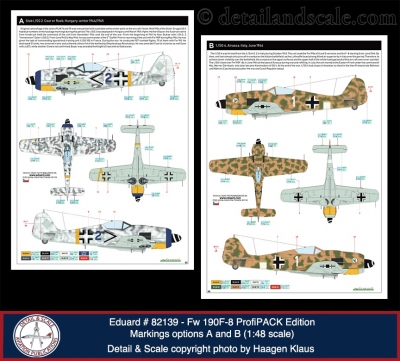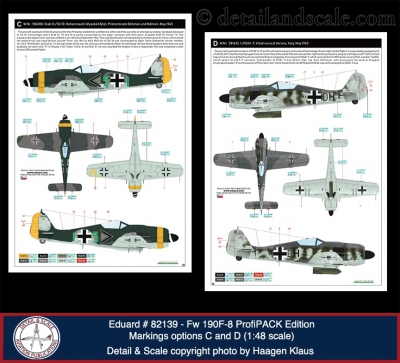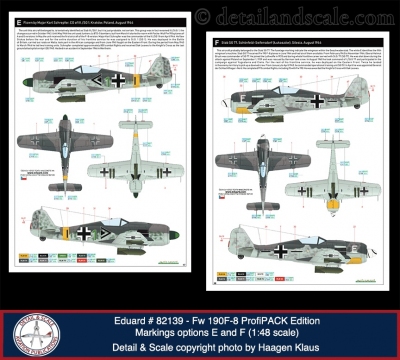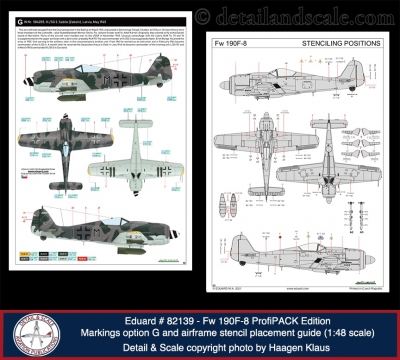Eduard # 82139 Fw 190F-8 ProfiPACK Edition —
1:48 Scale
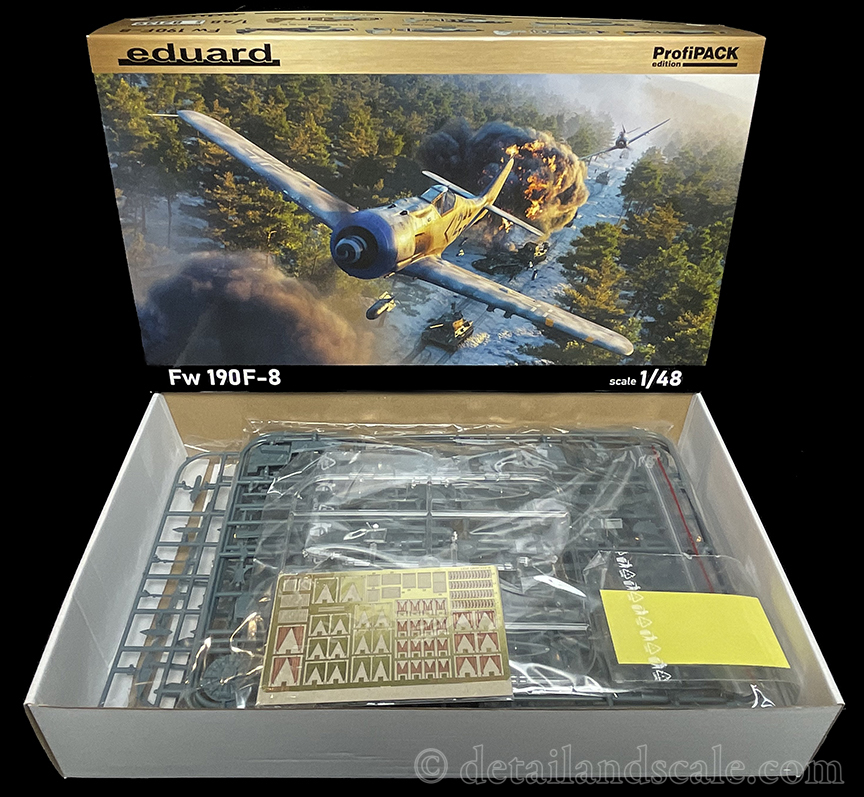
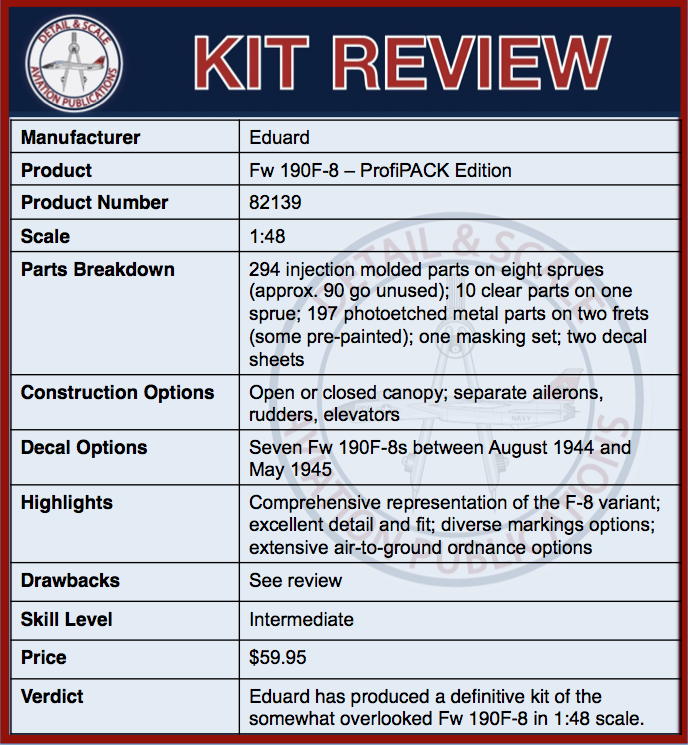
The Fw 190 was one of the most famous combat aircraft of the 20th century. Eduard’s family of new-tool Fw 190As in 1:48 scale has been ever-growing, definitively capturing all the different variants of the short-nosed Würger. In this review, we sit down with their recent release of the ground-attack Fw 190F-8 ProfiPACK edition kit.

In 1934, the German Ministry of Aviation (RLM) issued a call for proposal for a modern fighter design to definitively rearm and modernize the Luftwaffe. The Bf 109 was selected in 1936, but by 1937, the RLM saw a need for a second fighter to complement the Bf 109. Focke-Wulf designers led by Kurt Tank took another look at their losing Fw 159 prototype. The design reached maturity with inclusion of an air-cooled, 14-cylinder BMW 139 radial engine, a low-drag cowling and other aerodynamic improvements, and extensive use of electrically driven controls that made handling crisper and more responsive. The first of nearly 20,000 Fw 190 Würgers (or Shrikes) flew on 01 June 1939. The Fw 190 was arguably the Luftwaffe’s most effective day fighter, serving in every corner of Europe and North Africa. Many pilots felt that the Fw 190 was superior to the Bf 109 in terms of armament and low to mid-altitude performance.
The Fw 190 excelled as a fighter-bomber, and the Fw 190F-8 was a dedicated ground attack variant. It was derived from the Fw 190A-8 air-to-air fighter. As such, the F-8 featured some tweaks to its BMW powerplant to optimize low-altitude performance. It was also fitted with up to four ETC 50 underwing bomb racks and one centerline ETC 501 bomb rack for carriage of diverse air-to-ground stores up to a 500 kg bomb.

Eduard’s ProfiPack edition of the Fw 190F-8 comes on eight sprues holding a total of 294 parts (about 90 go unused). Ten clear parts are also found on one sprue. As a ProfiPACK edition, there’s also two frets of pre-painted photoetched metal parts. One is a pre-painted cockpit detail set containing 47 parts, and the other is an unpainted fret that features nearly 150 parts used to detail the air-to-ground ordnance. A pre-cut self-adhesive masking set is also included. The full-color instruction booklet guides the build over a dozen pages. The decal sheets provide full airframe stencils and markings for seven airplanes:
- Fw 190F-8, Stab I./SG 2, Csar or Raab, Hungary, Winter 1944/1945
- Fw 190F-8, 1./SG 4, Airasca, Italy, June 1944
- Fw 190F-8 W.Nr. 586188, Stab III./SG 10, Hohenmauth (Vysoké Mýto), Protectorate Böhmen und Mähren, May 1945
- Fw 190F-8 W.Nr. 581632, I./NSGr. 9, Villafranca di Verona, Italy, May 1945.
- Fw 190F-8, flown by Major Karl Schrepfer, CO of III./SG 1, Kraków, Poland, August 1944
- Fw 190F-8, Stab SG 77, Schönfeld-Seifersdorf, (Łukaszów), Silesia, August 1944.
- Fw 190F-8, W.Nr. 484205, III./SG 3, Sabile, (Zabeln), Latvia, May 1945
Strengths: Four years after their first new-tool Würgers appeared in hobby shops, Eduard’s quest to release kits of all the short-nosed Fw 190s in 1:48 scale continues its momentum with this release of this Fw 190F-8. Prior to this, there were only two other Fw 190F-8s in this scale, and they were produced by Trimaster/Dragon and Tamiya and in the late 1980s and early 1990s, respectively. While those were nice kits, such older tooling and kit designs simply cannot hold up to what Eduard offers here.
This kit is directly based on the tooling of Eduard’s Fw 190A-8 kits. The second PE fret and the additional Sprues M, S1, and T provide parts to make this an F-8. Sprue M also features a slightly retooled lower wing with the blanked-over cannon access hatches.
All of the observations and accolades that apply to Eduard’s previous new-issue Fw 190s apply here. Parts breakdown and overall engineering result in a kit that is quite straightforward and easy to build. Construction is straightforward and fit is excellent. Surface detail is outstanding as expected from Eduard, with beautifully executed and restrained recessed panel lines and elegant recessed rivet details arrayed into complex and accurate patterns.
The plastic cockpit parts by themselves are a somewhat simplified. Yet, the 47 pre-painted photoetched metal parts for the instrument panel, side consoles, shoulder harnesses, and lap belts (among other detail parts) provide an impressive level of detail. Engine exhaust stacks are okay for 1:48 scale. The exhausts themselves are not hollow as a resin casting can achieve (but there’s a Brassin set for that). Still, the kit parts do feature slightly recessed faces and a good wash of a dark color can achieve the illusion of a deeper exhaust.
The landing gear, tires, and tailwheel assembly are all nicely detailed and molded. The rudder, elevators, and ailerons are all separate parts. At least for the rudder, the mounting tab forces a straight-in fit, so a little modification might be necessary to fit the rudder in a deflected position. The clear parts are gorgeous and possess perfect optical quality with no seams present. Likewise, the pre-painted photoetched parts are beautifully made.
In terms of air-to-ground ordnance and external stores, Eduard has provided a very thorough range of options for their Fw 190F-8. Included here are:
- AB 250 bombs
- AB 500 bombs
- SC 50 bombs
- SC 250 bombs
- SC 500 bombs
- SD 250 bombs
- Mk 103 underwing cannon pods
- Ps 2 rockets tube launchers
- Pb1 (early) rockets
- Pb1 (late) rockets
- ETC 503 and ETC 50 pylons
- Rocket pylons and launch rails
- Centerline drop tank
This range of ordnance indeed provides a lot of opportunities for scale modelers. The thin photoetched parts for bomb fins and fin braces will allow for the best-looking, scale-accurate representation of these items.
The decal sheets were printed in-house by Eduard and cover the six well-chosen and eye-catching schemes described above. There’s also a complete set of airframe stencils. Note that these are of the new “wet-transfer” type of decal. Alternate decal versions of the instrument faces are also provided if working with the PE parts is not the builder’s preference. Decal printing appears perfect. Everything is in register and colors look great.
Weaknesses: There’s very little to critique here. First, the landing flaps are not molded as separate parts, but there’s an Eduard PE set for that. Second, I do believe the inboard main gear well doors should be closed in the parked position, as those doors cycled open and then closed when the gear was either retracted or extended. Third, the gear wells are just a bit simplified. I can confirm this particularly as I had my head up in the gear wells of a pair of 190s during my last trip to the Military Aircraft Museum in Virginia Beach, Virginia. Again, there’s plenty of photoetched and Brassin sets to take care of any “soft” detail there, and almost anyone can add the appropriate wiring/plumbing in the wells with very little effort. At the end of the day, these three points do not represent substantive critiques but things to think about as you plan your build.

Overall, this is another excellent 1:48 scale kit of the Fw 190 from Eduard. For many scale modelers, especially those interested in adding even more features to the Eduard Fw 190F-8, Eduard has released a wide range of cockpit, engine, machine gun, and cannon bay detail sets to cater to practically any and every extra level of detail one might desire. Würger fans will be very happy to see such a well-done Fw 190F-8 on the market. Eduard’s F-8 definitively unseats the Tamiya and Trimaster/Dragon kits, and it is clearly the best 1:48 scale Fw 190F-8 available today.
Sincere thanks are owed to Eduard for the review sample. You can visit them on the web at http://www.eduard.com and on Facebook at https://www.facebook.com/EduardCompany
Haagen Klaus
Scale Modeling News & Reviews Editor
Detail & Scale


